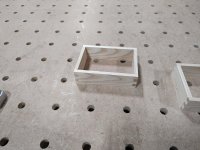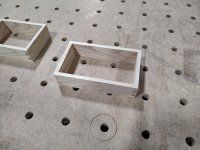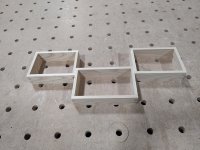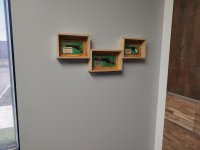Crazyraceguy
Member
- Joined
- Oct 16, 2015
- Messages
- 5,559
Shaper Origin box-joint project.
I have done box-joints several different ways, dado in the table saw, router table, and even Leigh dovetail jig. The most significant difference is that with those methods, is that the width of the panel is largely unimportant. Meaning that, once set-up, cutting parts for a 6" wide drawer is no different than a 4" drawer, except you have to keep cutting a little longer.
With the Origin, it matters because the thing is doing the "math" for you.
All you have to do is tell the thing how wide your parts are, and how many total pins you want. This is why the width matters, it won't "just keep cutting". Adjusting the fit is very easy too, right on the screen.
This was pretty simple. 2" wide and 5 pins total.
3/8" thick Ash
I think the final configuration is going to be the group of three, glued together as one.
I have done box-joints several different ways, dado in the table saw, router table, and even Leigh dovetail jig. The most significant difference is that with those methods, is that the width of the panel is largely unimportant. Meaning that, once set-up, cutting parts for a 6" wide drawer is no different than a 4" drawer, except you have to keep cutting a little longer.
With the Origin, it matters because the thing is doing the "math" for you.
All you have to do is tell the thing how wide your parts are, and how many total pins you want. This is why the width matters, it won't "just keep cutting". Adjusting the fit is very easy too, right on the screen.
This was pretty simple. 2" wide and 5 pins total.
3/8" thick Ash
I think the final configuration is going to be the group of three, glued together as one.





